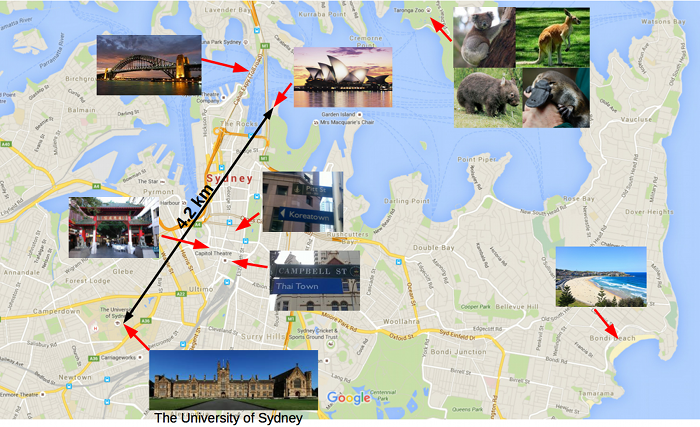Major tourist attractions
Sydney Opera House Home to Australia's national opera company Opera Australia and the Sydney Symphony Orchestra, the Opera House also regularly hosts performances by the Sydney Theatre Company and the Australian Ballet. Full performance schedule can be found at the Opera House website. Also on offer is a one-hour guided tour of the Opera House itself.
Sydney Harbour Bridge This iconic landmark is visible from virtually every harbour-front location around Sydney (e.g., from the Opera House). There is a pedestrian walkway on the eastern side of the Bridge that can be accessed for free from The Rocks on the south side of the Harbour and Milsons Point on the north side. If you absolutely must climb to the top and don't mind shelling out $150 to $400 for the experience, BridgeClimb offers various climb packages (including equipment) to healthy individuals over the age of 10.
The Royal Botanic Garden Plants are of course nice. But the main attraction here is arguably Fleet Steps, which offers that iconic photo opportunity of Sydney Harbour, the Opera House and the Harbour Bridge all in one single frame.
Darling Harbour A vibrant dining and entertainment precinct on the western outskirt of Sydney's Central Business District, Darling Harbour houses such attractions as Madame Tussauds, IMAX Sydney, Hard Rock Cafe, the Australian National Maritime Museum, and SEA LIFE Sydney Aquarium.
Harbour Cruises Plenty of private companies operate harbour cruises with or without dining options departing from Circular Quay or Darling Harbour. The budget way to experience the Harbour, however, is by public transport: Sydney Ferries runs regular services from Circular Quay to various waterfront locations on the Harbour and Parramatta River. See route map. From Circular Quay the two westbound routes F3 and F4 will take you directly under the Bridge, while the eastbound routes F1 and F7 will get you to the headlands.
Bondi Beach Not just for beach bums and surfer dudes, Bondi Beach is gateway to the Bondi to Coogee Walk, a 6-km cliff-top coastal talk connecting five beaches in Sydney's eastern suburbs. The walk also passes the scenic Waverley Cemetery, the final resting place of many prominent Australians.
Manly Reachable by ferry from Circular Quay (route F1), Manly is most notable for its beaches. A number of coastal walks begin/end in Manly, including the 10-km Manly-Spit Bridge Walk and the 9.5-km Manly to North Head Walk.
Taronga Zoo No, there are no kangaroos and koalas living in people's backyards. Not in Sydney anyway. You have to go to the zoo to see them. Accessible from Circular Quay by ferry (route F2).
Blue Mountains A World Heritage Site about 2 hours by car west of Sydney, many coach companies offer day trips to the Blue Mountains, mostly departing from Circular Quay. Alternatively, you can catch the train from Central Station (Blue Mountains Line) to Katoomba, join a local tour there or explore the area on your own on foot. Sturdy footwear recommended.
Dining options
On Campus
Ralph's Cafe in the Arena Sports Centre just across the road from the Physics Building offers coffee, cake, and light meals. See here for other on-Campus eateries.
Around Campus
There is a high concentration of reasonably-priced restaurants on Glebe Point Road and on King Street, Newtown (the former being generally a bit more expensive than the latter). Broadway Shopping Centre has a food court on level 2.
City Centre and Surrounds
Chinatown Roughly defined by the area bounded by George, Quay, Harbour, and Liverpool Streets, Sydney's Chinatown has a large number of eateries serving various Chinese regional cuisines as well as other Asian cuisines. International chains Din Tai Fung and Tim Ho Wan have branches on George Street (and also at other locations around Sydney).
Koreatown High concentration of Korean BBQ places mainly around the intersection of Pitt and Liverpool Streets.
Darling Harbour Waterfront dining. Mainly modern Australian (whatever that means). Can be quite pricey: you do pay for the view.
The Rocks This end of town is generally more upscale, and is home to a good number of Sydney's award-winning fine-dining restaurants.
Surry Hills Formerly a Bohemian neighbourhood, now home to a large number of cafes, bars, and restaurants, mainly on and off Crown Street.
See Fairfax's Good Food and the Australian Good Food and Travel Guide for more information on dining options around Sydney.
Some hints
Tipping is entirely voluntary. By all means feel free to leave some money to show your appreciation of exceptional service rendered to you by the waiting staff. But with fixed wages and a national minimum wage set at $17.70 per hour, the highest in the world, the waiting staff does not strictly depend on tips to survive. At mid-range and more upscale restaurants it has become quite common to round up the bill to the nearest $5 or $10, or by up to about 10% (which is already considered rather generous). But no one will bat an eyelid if you insist on getting every last cent of your change back.
Most restaurants will not split bills. Cheaper (usually Asian) places often accept only cash payments, or may impose a surcharge if you pay with a card. All are good reasons to carry some cash on you.
